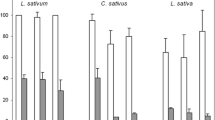Abstract
A bioassay for rhizosphere-applied phytotoxicants was developed and evaluated with a broad range of chemicals. Test substances were applied to the rhizosphere of whole, intact bush bean plants (Phaseolus vulgaris L. cv. Bush Blue Lake 290) grown in a solid support medium and the resultant ethylene production was measured to detect the presence of phytotoxic materials. The beans were encapsulated in plastic bags for 2 hr following treatment and then incubated for 24 hr in the dark. Ethylene and ethane accumulating within the bags were quantified via gas-solid chromatography. The application of various concentrations of inorganic and organic chemicals induced various responses. No single equation adequately described the dose-response curves; therefore, a critical value (a statistically significant increase in stress ethylene) was computed for each test substance. A phytotoxic-response threshold for each test substance was defined as the test-substance concentration that caused ethylene production to exceed its respective critical-value concentration. Based on threshold concentrations determined by analysis of stress ethylene production, the relative phytotoxicity rankings of the inorganic test substances were: CdCl2>CuCl2>Pb(C2H3O2)2>LiCl, while those of the organic test substances were 2,4-D esters>paraquat dichloride>1-butanol>2-propanone>2-propanol. Both stress ethylene and ethane production were nonresponsive to hydrogen-ion concentration (measured before application) over a broad pH range. However, significant ethane production was detected at pH 2 and stress ethylene was produced at pH 1. The measurement of stress-induced ethylene provides a rapid and simple means to determine the relative phytoxicity of rhizosphere-applied substances.
Similar content being viewed by others
References
Abeles, F. B.: 1973, Ethylene in Plant Biology. Academic Press. New York.
Bancroft, T. A.: 1968, Topics in Intermediate Statistical Methods. Vol. I. The Iowa State University Press. Ames, Iowa.
Baur, J. R. and Morgan, P. W.: 1969, ‘Effects of Picloram and Ethylene on Leaf Movement in Huisache and Mesquite Seedlings’, Plant Physiol. 44, 831–838.
Ben-Yehoshua, S. and Biggs, R. H.: 1970, ‘Effects of Iron and Copper Ions in Promotion of Selective Abcission and Ethylene Production by Citrus Fruit and the Inactivation of Indoleacetic Acid’, Plant Physiol. 45, 604–607.
Chaney, R., Brown, J. C., and Tiffin, L. O.: 1972, ‘Obligatory Reduction of Ferric Chelates in Iron Uptake by Soybeans’, Plant Physiol. 50, 208–213.
Elstner, E. F. and Konze, J. R.: 1976, ‘Effect of Point Freezing on Ethylene and Ethane Production by Sugar Beet Leaf Disks’, Nature 263, 351–352.
Guinn, G.: 1977, ‘Effects of Some Organic Solvents on Ethylene Evolution from Young Cotton Bolls’, Plant Physiol. 60, 446–448.
Hogsett, W. E., Raba, R. M., and Tingey, D. T.: 1980, ‘Inhibition of Stress-Induced Ethylene by the Rhizobitoxine Analog, Aminoethoxy-vinylglycine’, Plant Physiol. 65, 84 (supplement).
Lieberman, M.: 1979, ‘Biosynthesis and Action of Ethylene’, Annu. Rev. Plant Physiol. 30, 533–591.
Maksymowych, R.: 1973, Analysis of Leaf Development. Cambridge at the University Press. Cambridge, England.
Nakagaki, Y., Hirai, T., and Stahmann, M. A.: 1970, ‘Ethylene Production by Detached Leaves Infected with Tobacco-Mosaic Virus’, Virology. 40, 1–9.
Nieboer, E. and Richardson, D. H. S.: 1980, ‘The Replacement of the Nondescript Term ‘Heavy Metals’ by a Biologically Significant and Chemically Significant Classification of Metal Ions’, Environ. Pollution (Series B). 1, 3–26.
Samimy, C.: 1978, ‘Influence of Cobalt on Soybean Hypocotyl Growth and Its Ethylene Evolution’, Plant Physiol. 62, 1005–1006.
Shain, L. and Wheeler, H.: 1975, ‘Production of Ethylene by Oats Resistant and Susceptible to Victorin’, Phytopathology. 65, 88–89.
Snedecor, G. W. and Cochran, W. G.: 1968, Statistical Methods, 6th ed. The Iowa State University Press. Ames, Iowa.
Tingey, D. T.: 1980, ‘Stress Ethylene Production — a Measure of Plant Response to Stress’, HortScience. 15, 630–633.
Tingey, D. T.: Pettit, N., and Bard, L.: 1978, ‘Effect of Chlorine on Stress Ethylene Production’, Environ. Expt. Bot. 18, 61–66.
Tingey, D. T., Standley, C., and Field, R. W.: 1976, ‘Stress Ethylene Evolution: a Measure of Ozone Effects on Plants’, Atmos. Environ. 10, 969–974.
Thompson, C. R., Kats, G., Dawson, P., and Doyle, D. A.: 1981, ‘Protocol for Measuring the Relative Toxicity of Substances on Plant Foliage’, Bull. Environ. Contam. Toxicol. 26, 281–287.
Webb, D. T., Darrow, R. A. and Leather, G. R.: 1975, ‘Appraisal of Ethylene Production as a Test for Defoliants’, J. Agric. Food Chem. 23, 1113–1115.
Yu, Y-B. and Yang, S. F.: 1979, ‘Auxin-Induced Ethylene Production and Its Inhibition by Aminoethoxyvinyl-glycine and Cobalt Ion’, Plant Physiol. 64, 1074–1077.
Yu, Y-B. and Yang, S. F.: 1980, ‘Biosynthesis of Wound Ethylene’, Plant Physiol 66, 281–285.
Author information
Authors and Affiliations
Rights and permissions
About this article
Cite this article
Rodecap, K.D., Tingey, D.T. Stress ethylene: A bioassay for rhizosphere-applied phytotoxicants. Environmental Monitoring and Assessment 1, 119–127 (1981). https://doi.org/10.1007/BF00395117
Issue Date:
DOI: https://doi.org/10.1007/BF00395117




